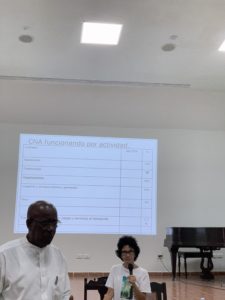Much of the primary information comes from a lecture by Dr. Jesus Cruz Reyes, on January 13, 2020 in Havana, Cuba. Dr. Cruz Reyes is Cuba’s foremost cooperative economist and is on the faculty of economics at the University of Havana.

The Cuban “State Enterprise” is undoubtedly the single largest economic consumer and producer in Cuba. Since the 1959 revolution, the State nationalized and has controlled most of the country’s key assets, from land to housing, farms, factories, automobiles, hotels and even workers. Beginning in the 1990’s, when the State realized the defunct Soviet Union could no longer maintain its level of purchasing, the State began a slow and measured transition to non-state enterprise. First, by transitioning control of agricultural production to cooperatives, the State turned over the “means of production”, and not the land, to agricultural cooperatives. Today, cooperatives produce approximately 80% of food consumed or produced in Cuba, from sugar, corn, tobacco, rum, honey and charcoal.
After the fall of the Soviet Union, Cuba entered what is referred to as the “Special Period”, roughly a decade of disruption, scarcity, anxiety and awakening. Not 40-years into the socialist revolution, Cuba was faced with the demise of its largest economic trading partner and political ally. Herein, Cuba’s Communist Party, General Assembly, and civil society faced the uncomfortable tension of having fought for its autonomy from imperialism (from Spain and then from the U.S.) only to have to rely on the Soviet Union for its basic survival.
By 2000, Cuba’s industry and agriculture had not yet recovered. The Special Period had all but halted economic production. Trade had become woefully imbalanced. Yet, key secondary sectors such as tourism, restaurants and professional services had sustained capacity. In 2008 the U.S. triggered financial collapse effected Cuba, but not in ways one might imagine. Revenues from domestic sugar production slowed and were replaced by more extractive nickel exports. Tourism had become more of a primary economic engine since it brought in foreign capital.
In 2011, Cuba’s national Congress began promoting non-agricultural cooperatives. In 2013, the Assembly adopted the country’s first law governing non-agricultural cooperatives.
As of this writing, there are 403 non-agricultural cooperatives with more than 20,000 members. The vast majority of these are worker cooperatives.
The embargo has choked off Cuba’s potential for consumerism; Cubans can’t buy or import American products and producers in many other countries are too scared of U.S. sanctions to export to Cuba. Cubans also live on an average of $30 per month…yes per MONTH. Cuba is a largely non-financialized and de-monetized economy. This means consumer cooperatives would have a limited market or offer limited utility to the average Cuban; particularly since the State provides in ways that satisfies most basic needs (housing, healthcare, education, food, transportation).
There are two primary pathways for cooperatives to develop in Cuba.
- By far the most prevalent of the cooperatives I visited (and likely similarly across all 403 non-agricultural, and even agricultural, cooperatives) were born from State enterprise. Due in large part to the State’s recognition in the early 2000’s that it could no longer maintain control over all sectors of the economy, the State began divesting its operations (note: not land or real estate) in restaurants, industry, services, and production (e.g. ceramics, furniture).
- Less commonly, groups of persons can come together to form a cooperative.
To date, there is no umbrella organization that acts as a trade association or technical assistance provider to the non-agricultural cooperative sector. Non-ag cooperatives have had to go to Mondragon, Brazil, Argentina, and Italy for technical assistance, education and even solidarity. The non-ag cooperative sector in Cuba is not well organized or connected.
Non-ag cooperatives are today demonstrating they can provide cheaper and better service (than the State) and create and sustain stronger community linkages. For instance, construction cooperatives are able to donate quality services to healthcare and education centers.
The cooperative sector in Cuba is not without problems, to be sure. Dr. Cruz Reyes opines:
- Legislative and rule changes make the cooperative legal framework unpredictable.
- Co-ops suffer from endemic and system issues in Cuba; lack of raw materials and energy resources.
- Local officials are reported to sometimes discriminate against cooperatives (usually for lack of understanding).
- Cooperatives are only just starting to develop internal capacity to solve problems and adapt within commercial structures.
- In contrast to (and some might say advantageously) the U.S., Cubans do not have a well developed sense of ownership, empowerment, and many still view themselves as “ordinary workers”.
Dr. Cruz Reyes recommends (sound familiar?):
- the need to strengthen management capacity.
- Strengthen member engagement.
- Establish operating and cultural norms.
- Undue prejudices within cooperatives (distinguish from the third sector of private enterprise).
- Establish and follow clear and documented rules of governance.
There is reason to be optimistic.
- More than 90% of the labor force in Cuba is unionized. While trade unions do not understand (and many do not support) cooperatives, the rich tradition of solidarity and mutualism will make for an easier transition to cooperation.
- Scholars such as Dr. Cruz Reyes sit on the National Association of Economists, which is developing capacity to offer technical assistance to cooperatives.
- On April 28 and 29 there will be a symposium on cooperatives at the University of Havana.
- As will be discussed in a future installment, the new 2019 cooperative law offers credit and technical assistance to new cooperatives. This is allowing Cuban banks to also begin to lend to new cooperatives. Cooperative members also commonly have a material “buy-in”, which they can finance over time through the cooperative. Together, this evinces a strong commitment by the State to support cooperatives.
In another installment in this series, I will summarize the 2013 Cooperative Law and the 2019 Cooperative Reform Law.
